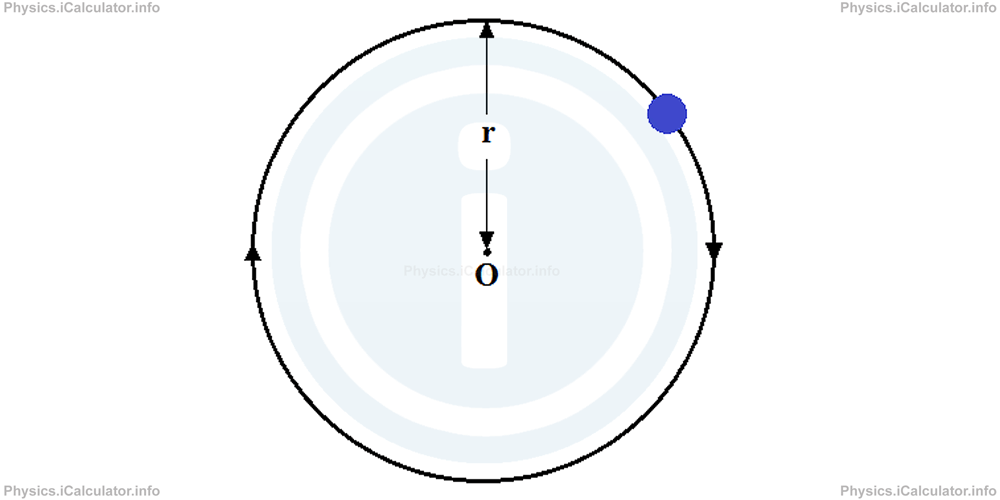Menu
Physics Lesson 7.1.1 - Understanding Some Useful Quantities of Rotational Motion as a Background
Please provide a rating, it takes seconds and helps us to keep this resource free for all to use
Welcome to our Physics lesson on Understanding Some Useful Quantities of Rotational Motion as a Background, this is the first lesson of our suite of physics lessons covering the topic of Kinematics of Rotational Motion, you can find links to the other lessons within this tutorial and access additional physics learning resources below this lesson.
Understanding Some Useful Quantities of Rotational Motion as a Background
Before starting with Kinematics of Rotational Motion, it is better to discuss some quantities, somehow (albeit not always directly) involved in this kind of motion.
a. Radius of curvature
As explained in Physics tutorial "Motion. Types of Motion", a circular (rotational) motion involves the rotation of a particle about a fixed point in space by always keeping the same distance from this fixed point. Therefore, a rotational motion implies moving around a circle whose centre and radius are fixed as shown in the figure below.

Therefore, radius of curvature is a fundamental parameter that appears in most formulae of rotational motion, as it is an indicator of the object's position at any instant.
b. Period of rotation
The time neccessary to make one complete revolution around a fixed point is called Period, T. It is measured by the unit of time, i.e. second, [s]. Period is a very important quantity as it also helps us limit the study of a rotational motion to a single rotation if we are sure that the parameters won't change during the entire process. It is just like studying a small group of people regarding a certain phenomenon and then generalize the outcome for a wider group or society.
For example, period of the second hand of a clock is T = 60 s for all kinds of clocks, from the smallest to the biggest, as it always takes 60 s for such a hand to make one complete rotation.
Another example: the period of Earth revolution around the Sun is about 365 days as this is the time needed for the Earth to make a complete revolution around the Sun.
Period is very suitable to use when a revolution process occurs slowly.
c. Frequency of rotation
When an object rotates very fast around a fixed point, period results in a very small number. Therefore, to avoid the use of decimals, in such cases it is more suitable using the inverse of period, known as Frequency, f, to represent the time-related phenomena. Frequency is measured in revolutions per second but this unit is widely recognized as Hertz [Hz].
Thus, we have
and
For example, if an object makes 10 revolutions per second around a fixed point, its period is
This result means it takes 0.1 s to this objet to make a complete revolution.
Example 1
The drum of a washing machine makes 1200 rpm (rotations per minute). Calculate:
- Frequency of drum's rotation
- Period of drum's rotation
Solution 1
a. To calculate the frequency, we have to convert rpm into rps (revolution per second). We have
b. Period of drum's rotation therefore is
You have reached the end of Physics lesson 7.1.1 Understanding Some Useful Quantities of Rotational Motion as a Background. There are 4 lessons in this physics tutorial covering Kinematics of Rotational Motion, you can access all the lessons from this tutorial below.
More Kinematics of Rotational Motion Lessons and Learning Resources
Whats next?
Enjoy the "Understanding Some Useful Quantities of Rotational Motion as a Background" physics lesson? People who liked the "Kinematics of Rotational Motion lesson found the following resources useful:
- Quantities Feedback. Helps other - Leave a rating for this quantities (see below)
- Rotation Physics tutorial: Kinematics of Rotational Motion. Read the Kinematics of Rotational Motion physics tutorial and build your physics knowledge of Rotation
- Rotation Revision Notes: Kinematics of Rotational Motion. Print the notes so you can revise the key points covered in the physics tutorial for Kinematics of Rotational Motion
- Rotation Practice Questions: Kinematics of Rotational Motion. Test and improve your knowledge of Kinematics of Rotational Motion with example questins and answers
- Check your calculations for Rotation questions with our excellent Rotation calculators which contain full equations and calculations clearly displayed line by line. See the Rotation Calculators by iCalculator™ below.
- Continuing learning rotation - read our next physics tutorial: Dynamics of Rotational Motion
Help others Learning Physics just like you
Please provide a rating, it takes seconds and helps us to keep this resource free for all to use
We hope you found this Physics lesson "Kinematics of Rotational Motion" useful. If you did it would be great if you could spare the time to rate this physics lesson (simply click on the number of stars that match your assessment of this physics learning aide) and/or share on social media, this helps us identify popular tutorials and calculators and expand our free learning resources to support our users around the world have free access to expand their knowledge of physics and other disciplines.